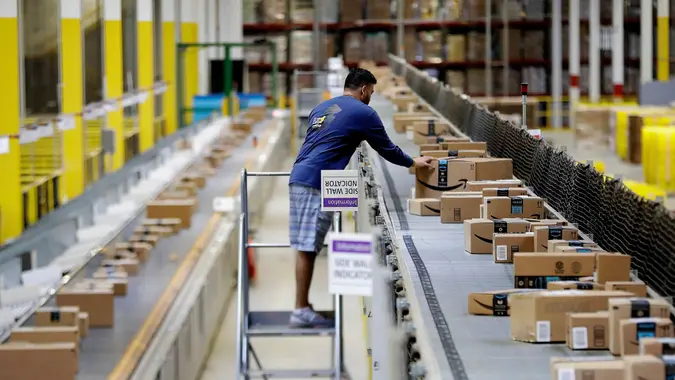I’m a Successful Reseller: 5 Unexpected Expenses When You Start Reselling Items

Commitment to Our Readers
GOBankingRates' editorial team is committed to bringing you unbiased reviews and information. We use data-driven methodologies to evaluate financial products and services - our reviews and ratings are not influenced by advertisers. You can read more about our editorial guidelines and our products and services review methodology.

20 Years
Helping You Live Richer

Reviewed
by Experts

Trusted by
Millions of Readers
The secondhand apparel market in the U.S. is expected to reach $73 billion in 2028, per the ThredUp 2024 Resale Report. The data also noted that the secondhand apparel market grew 11% in 2023, seven times faster than the overall retail clothing market. It doesn’t matter if you want to flip clothing or just general items, there’s money to be made with a side gig as a reseller.
However, before you enter this space, you want to be aware of the unexpected expenses that could impact someone just starting, according to two experienced resellers.
The Cost of Packaging
“The cost of packaging is often a surprise and unexpected source of lost profit for new resellers,” said Tina Bar, a business coach, online store owner and founder of Tina Bar Coaching. “The cost of the right-sized cardboard box, bubble mailers and packaging materials such as bubble wrap and packing peanuts is high if you need to buy at retail.”
The first unexpected expenses will occur before you even ship your items out. Regardless of the types of items you start reselling, you’ll have to figure in packaging costs, which is something that you may not think about at first. Bar noted that a simple order could run you anywhere from $3 to $10 in packaging costs, even before adding in shipping costs. This could easily eat into your expected profits.
What Can You Do About This Expense?
Bar pointed out that the best work-around is to save up packaging materials and re-use them. You can also join a local Buy Nothing group and ask for boxes and packing materials when you need them.
Platform Fees
“The second unexpected expense is platform fees, which can add up to anywhere from 15% to 25% of the order total,” Bar said. “Going for the sale without first calculating the final sale fees can result in an unprofitable reseller experience.”
Many resellers will overlook the platform fees, which can take a significant cut of your profits. Another platform fee that many resellers don’t consider is spending money on promotional boosts to enhance the visibility of the item they’re trying to flip. These expenses could quickly add up and hurt your profits.
What Can You Do About This Expense?
“Before choosing your resale channel, find out what cut they take, including listing fees, seller fees, credit card processing, discounts/platform promotions and shipping,” Bar said.
You’ll want to know the financial details in advance so you can price your products accordingly and avoid losing money.
Labor Costs
“Being a successful reseller of any size is very labor-heavy, especially if you’re brick-and-mortar as well as online,” said Jennifer Johnson, founder of True Fashionistas. “Going into this business, I had no idea how many people we would need to accomplish the tasks that we needed to do to get the items online and into the store for customers to purchase.”
Johnson said she started with one employee and is now almost at 50 as the business has grown. While this won’t always happen — you may decide to keep your venture small and do it all yourself — your expenses will significantly increase if you plan on growing your reselling venture.
What Can You Do About This Expense?
You have to decide in advance what the growth strategy will be for your reselling business. If you want to turn your reselling gig into a full-time venture, be prepared for the costs involved before moving forward.
Insurance
Johnson shared that she didn’t realize how high the cost of liability insurance and content insurance would be.
For example, you don’t own the items when you resell something on consignment instead of just purchasing it from the client. You need insurance in case something were to happen to the merchandise — fire, flood or any other possible damages — so the insurance would pay the consignors.
What Can You Do About This Expense?
You’ll want to get some insurance quotes if you plan on holding inventory or are worried about the items you have to store. You want to know what kind of fees you should expect so that you’re not blindsided.
Inventory Issues
Both resellers noted that inventory problems can be an unexpected expense that most aren’t prepared for. When you start reselling, you don’t foresee any issues occurring with your items, which can unfortunately cut into your business.
Inventory issues can come in a variety of forms, including:
- Refunds or returns. If a customer requests a refund or return, you could lose money on the shipping fees.
- Storage of inventory. You may have to rent space to store all of your inventory.
- Damaged inventory. Your items could get ruined in transportation or damaged if not stored properly.
- Purchasing the wrong items. You may think something will be a bestseller, but then you discover that the trend loses popularity.
What Can You Do About This Expense?
You don’t want to be stuck with a storage room filled with clutter, so it’s important to do your research and be careful about what you try to sell. You also want to be sure that you have the capacity for proper storage and transportation of the goods — you don’t want to have to stress about merchandise getting damaged.
More From GOBankingRates
- Nearly 1 in 3 Americans Hit by a Costly Holiday Scam, Norton Survey Shows -- How To Avoid This
- Here's What the Average Social Security Payment Will Be in Winter 2025
- How Middle-Class Earners Are Quietly Becoming Millionaires -- and How You Can, Too
- The Easiest Way to Score $250 for Things You Already Do
 Written by
Written by  Edited by
Edited by 

























